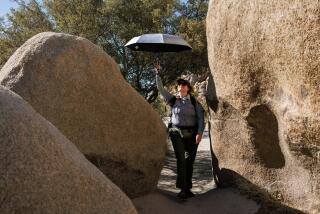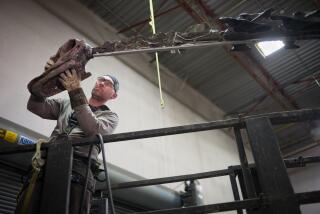‘Jurassic Park’ paleontologist offers advice on ways of dinosaurs
The blockbuster Steven Spielberg movie “Jurassic Park,” being re-released in 3-D on April 5, wouldn’t be the same place without paleontologist Jack Horner. In addition to advising the production on scientific matters, Horner provided inspiration for the character of Dr. Alan Grant in the original 1993 movie. Universal Pictures is preparing to shoot a fourth installment in the “Jurassic Park” series and will once again tap Horner to serve as an advisor.
“It’s fun to see a lot of the stuff that I do in there,” said Horner, curator of the Museum of the Rockies and professor at the University of Montana. “At the beginning, when Alan Grant looks out and says, ‘They do move in herds,’ that’s what I would have said. They almost duplicated our camp. And in fact, if you look at ‘Jurassic Park III,’ the truck that he gets out of even says ‘Museum of the Rockies Paleontology Department’ on it. I’m just glad my character hasn’t gotten eaten yet.”
FOR THE RECORD:
Jack Horner: A “Working Hollywood” article in the March 31 Calendar section about paleontologist Jack Horner said that he was on the faculty of the University of Montana. He is on the faculty at Montana State University. —
Like Grant, Horner hails from Montana. The son of a geologist who owned a gravel pit, Horner, now 66, found his first dinosaur bone at age 8 and his first dinosaur skeleton while in high school. Shy and dyslexic, he attended the University of Montana for seven years without obtaining a degree (although he did take time off from school to serve in Vietnam as a Marine).
PHOTOS: On Location in Los Angeles
After realizing that the gravel business wasn’t for him, Horner began writing letters to museums inquiring about jobs. In 1975, he accepted a position as a junior technician at Princeton University’s Museum of Natural History and received a promotion to research scientist after unearthing dinosaur eggs and embryos. In 1982, he returned to Montana to serve as the curator of the Museum of the Rockies, and four years later, he was awarded an honorary doctorate from the University of Montana as well as a MacArthur Fellowship.
With funding from George Lucas, his latest research project could easily inspire a new installment of “Jurassic Park.” Horner is creating a “chickenosaurus” by genetically modifying a bird to express ancestral traits such as hands and a tail.
“I want a real one,” he said. “Birds are dinosaurs, so really, all you have to do is fix them. It’s our first attempt to back up a little, back into evolution.”
Full spectrum: Movie dinosaurs aren’t nearly as glamorous as real ones, which were brightly colored. “Steven has made the point several times to me that colorful dinosaurs are not very scary,” Horner said. “Gray and brown and black are more scary. I worked on [the television series] ‘Terra Nova’ with Steven as well, and he did get some color into some of those. So I think by [‘Jurassic Park] IV,’ we’ll have a little more colorful animals.”
“Jurassic Park” will probably become a softer if not gentler place in the fourth movie. “In ‘Jurassic Park III,’ the raptors started sprouting feathery-looking things out of the top of their heads, but people were still of the opinion that most of the feathered dinosaurs were really little. But now we know that probably almost all dinosaurs had quite a bit of feathery stuff on them — even T. rex.”
RELATED: ‘Jurassic Park’ effects Wizard: We were copying mother nature
Like the birds sing: T. rex may have been a king of the jungle, but that doesn’t mean he roared like one. And duck-billed dinosaurs are thought to have honked. “Making sounds for dinosaurs, I make them for my dinosaur hall,” Horner said, referring to his museum. “And basically, all I do is I take bird sounds and just slow them way down to make them a little deeper, because we know birds are dinosaurs. I’m sure they were making sounds a long time ago, because most of these dinosaurs have pretty elaborate nasal passages. But to make them sound like a lion or a tiger, that’s really weird. That’s a mammal thing, I think.”
Scrap everything: Horner views T. rex as a scavenger that would occasionally take down an old or sick animal. “That was another one of those conversations [with Steven] that didn’t last very long,” he said. “But let me tell you: An 8,000-pound scavenger like a hyena would be the scariest thing on Earth. To be a scavenger, you have to be able to scare other animals away. You have to be smelly and scary and nasty. You don’t want to fight them for anything to eat.” Horner doesn’t believe that the real T. rex was a fast runner, either, but points out that “a slow T. rex isn’t going to be a very good star in a movie.”
Poison tales: In the original “Jurassic Park,” Dilophosaurus spits blinding, paralyzing poison at its prey. “That’s fictional,” said Horner. “Dilophosaurus is a good one to make a fictional character out of, because I think two specimens are known, and both of them are really crappy. They’re not preserved very well.”
Getting warmer: Horner considers dinosaurs warm-blooded. “Before the raptors enter the kitchen, what they do is they look through the window, and one of them snorts, and it fogs up the window,” he said. “Only a warm-blooded animal can do that. Before that scene, they were thinking that the animals would come in and wave their forked tongues around like snakes do. We had to take that out, because dinosaurs didn’t have forked tongues. So it was just little things that took the reptilian feel away from them and gave them more of a bird feel.”
PHOTOS AND MORE
TIMELINE: Violence in movies
ENVELOPE: The latest awards buzz
PHOTOS: Greatest box office flops
More to Read
From the Oscars to the Emmys.
Get the Envelope newsletter for exclusive awards season coverage, behind-the-scenes stories from the Envelope podcast and columnist Glenn Whipp’s must-read analysis.
You may occasionally receive promotional content from the Los Angeles Times.










